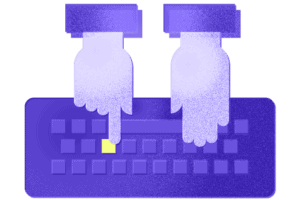AI content has revolutionized the digital marketing industry. It’s here, and it’s not going away any time soon. What does that mean for the content you receive from Verblio?
Verblio’s marketplace content is written by human subject matter experts
Verblio’s human writers have the experience and authority to create content for almost any niche. They excel at emulating brand voice and providing researched, factual arguments.
Robots do not. (Yet.).
Purely AI-generated content currently does not meet our quality standards. The writing it produces is often bland and repetitive. Worse, it could jeopardize your rankings and your reputation.
How does Verblio stop AI content from entering the marketplace?
Verblio utilizes a suite of leading-edge AI-detection tools, including Originality.ai. (Learn more than you thought possible about AI detection tools here.)
Originality.ai can detect content from OpenAI’s leading tools (GPT-3, GPT-3.5, and ChatGPT) with up to 94% accuracy. Currently, we screen every piece submitted on our platform with this tool, flagging articles likely to be written by AI. Collecting this data allows our internal teams to analyze patterns and identify contributors submitting AI-generated content.

Writers who submit pure AI content are penalized for doing so. Once identified, those writers are banned from our platform.
Our no-tolerance policy for AI-generated content ensures your 100% human-content is just that.
Why aren’t we using OpenAI’s AI Classifier?
OpenAI launched its own AI classifier to pinpoint which parts of a text were written by AI instead of humans. It works great. So, why aren’t we using it?
Right now, OpenAI’s AI Classifier doesn’t have an API, which means it’s not a scalable solution for us. Our internal teams would need to manually feed every piece of content through the classifier. Put simply: we’d run out of hours in the day.
By opting for tools that integrate AI-detection directly into our workflow, we can have faster response times.
Why do we use AI detection tools?
Customers who opt to buy content created by humans deserve to be assured that it actually is. And in a world where AI-generated content runs rampant, AI-detection tools are an important part of the process.
When left unchecked, AI content goes off the rails. It can go from not good to entirely illegible very quickly.

Your business is serious business. You deserve better.
Is AI content all bad?
We’d be wrong not to acknowledge the obvious: AI is an incredibly powerful tool. Like many other tools (hammers, tractors, airplanes), it opens up worlds of new possibilities when used correctly by skilled individuals.
Entirely AI-generated content certainly has its use cases — and some serious cost-saving perks. However, without human intervention, AI content doesn’t fit the bill for all of the content our customers need. It’s unreliable, unoriginal, and an SEO risk.

For faster, less expensive content at scale, we’ve created Human-Crafted AI content. By keeping humans in the driver’s seat, this offering produces high-quality content you can trust at about half the price of our human-only solution. And it only reaches you after it’s been edited, fact-checked, and quality-assessed by our team of expert writers.
But if your aim is truly unique, bespoke content that boosts domain authority, you’ll still want content written by humans.
Content you can count on
Even as the content world shifts with the development of new content production tools, our devotion to providing our customers with high-quality writing hasn’t changed. When you’re scaling your content production, you need reliable content you can trust.



